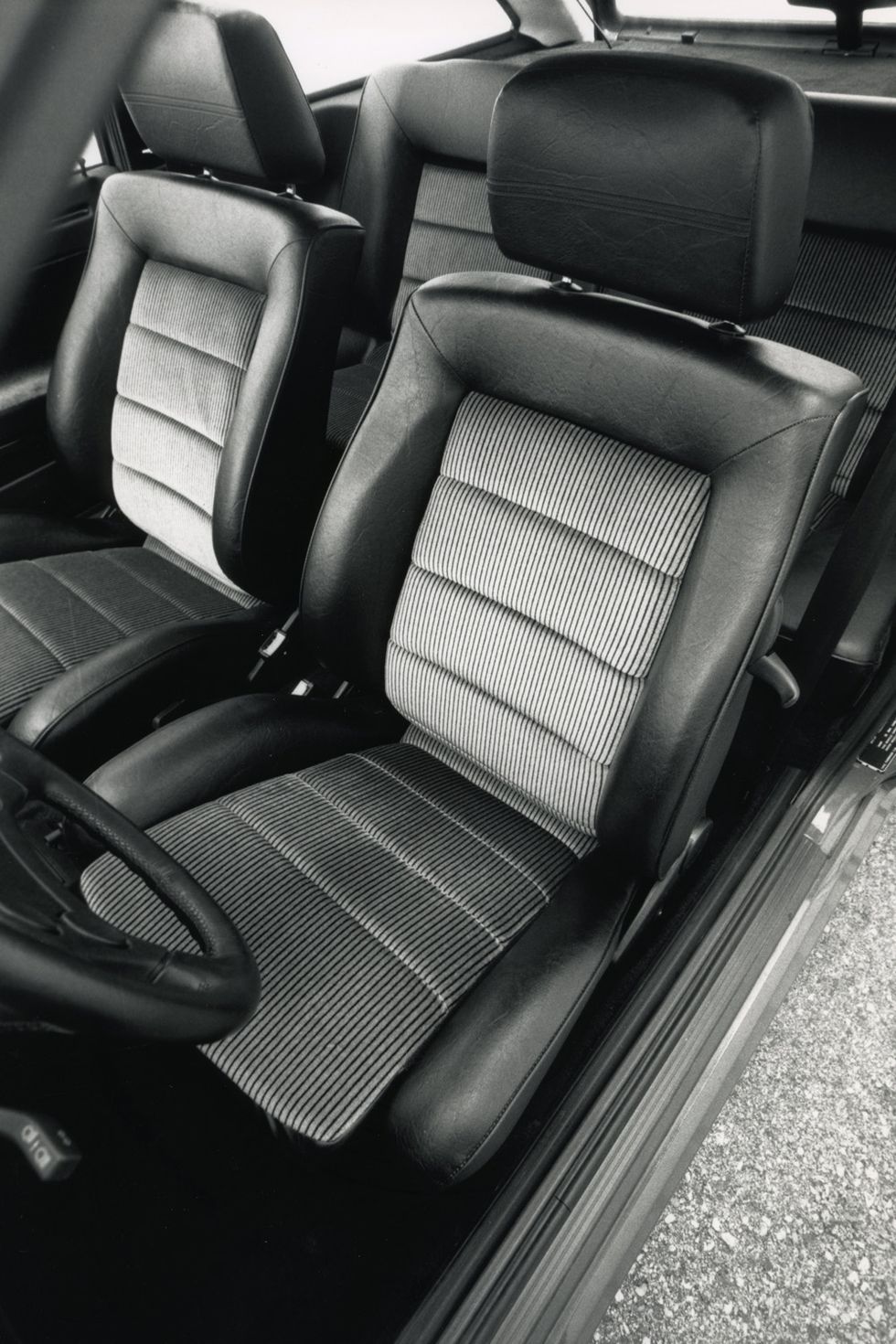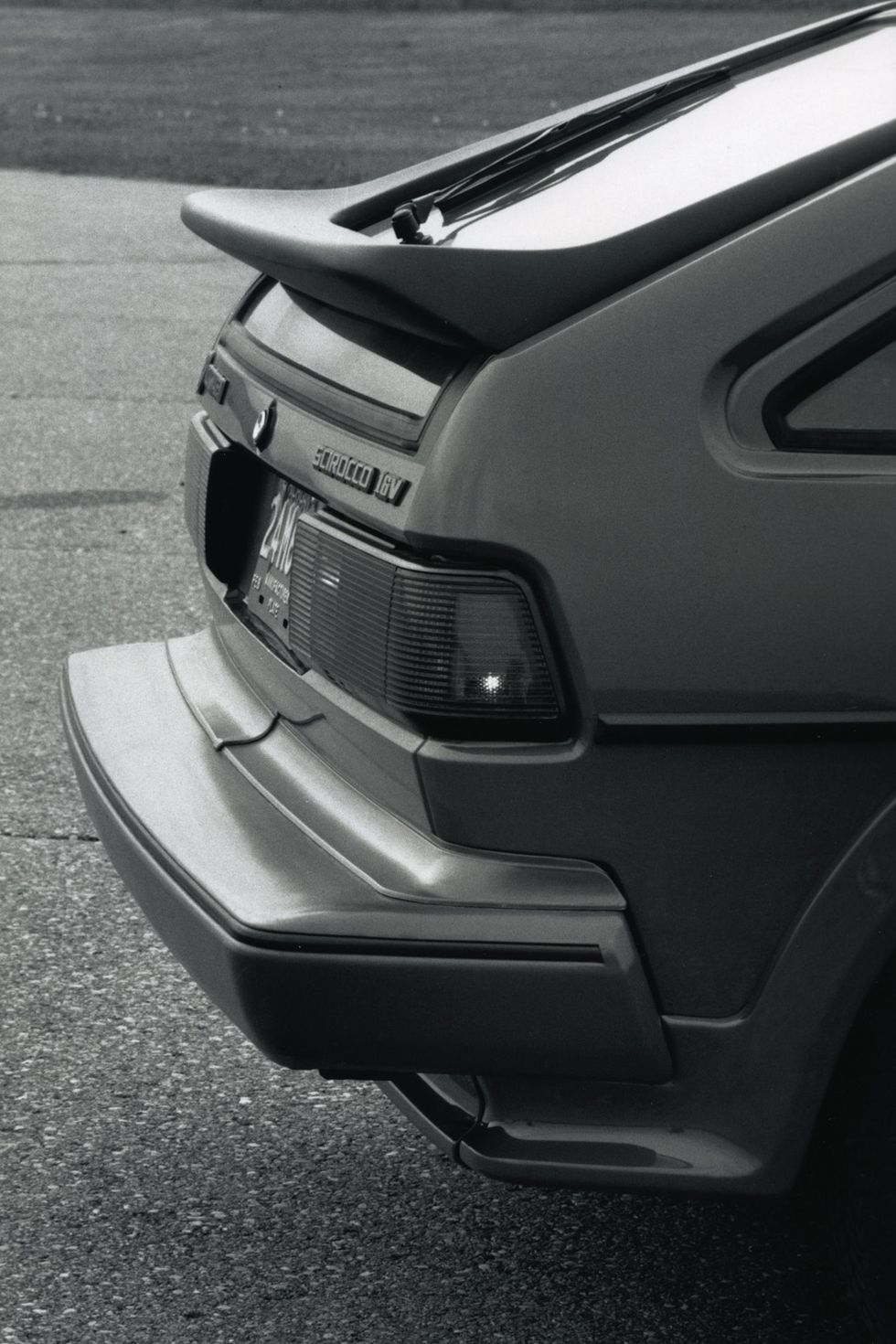1986 Volkswagen Scirocco 16V Tested: an Amazing Transformation

From the August 1986 issue of Car and Driver.
With one fell swoop, the wizards of Wolfsburg have transformed the ho-hum VW Scirocco from an also-ran into a supercoupe to be reckoned with. The principal element in this metamorphosis is a new twin-cam, sixteen-valve, four-cylinder engine, producing 123 horsepower and 120 pounds-feet of torque. This powerplant so strongly stimulates the Scirocco that it can now keep up with any of its competitors. Bring on your valiant V-6, your twin-cam, multivalve whiz-bang, your turbo tornado. This VW—the fastest and most powerful machine ever to wear those initials in America—is ready for all comers.
The Scirocco 16V, as it’s called, gobbles up the miles with the best of them. To go fast, you simply wind the new motor into its brilliant upper register. The 16V’s engine—which will also be fitted to VW’s GTI and Jetta GLI models early in the 1987 model year—motivates the Scirocco from rest to 60 mph in eight seconds flat and through the quarter-mile in 15.9 seconds at 87 mph. This strong performance continues even in the upper gears, with 100 mph arriving in 24.6 seconds—and the 16V still has another 24 mph to go before it tops out at 6350 rpm in fifth gear. At that point, the engine is more than 500 rpm past its power peak, which indicates the sheer breadth of the 16V’s pumped-up horsepower curve.
Dick Kelley|Car and Driver
The sixteen-valve Scirocco has enough punch to rocket by lazy dawdlers on a two-lane road, accelerate up a short ramp to freeway speed, or provide as much pleasure going up a mountain road as the eight-valve Scirocco can provide going down one. And although most of the additional power is concentrated above 4000 rpm, the 123-hp engine is no less willing at any speed than the 90-hp, single-cam, eight-valve motor that powers the base Scirocco. The 16V’s acceleration times in top gear bear this out: The high-output engine pushes the Scirocco from 30 to 50 mph in 10.6 seconds and from 50 to 70 mph in 11.3 seconds without any hesitation, fuss, or protest.
In fact, we could discern absolutely no penalty or loss of refinement as a result of the additional 33 horsepower. The new engine starts easily, idles smoothly, and displays exemplary drivability even when cold. And it revs like a kitchen blender. The Scirocco’s new engine isn’t particularly quiet, and it takes on a very purposeful note near its redline, but its only really irritating trait is that its power is interrupted by a rev limiter at 7000 rpm, 200 revs below the forbidden zone. Two hundred rpm doesn’t matter one way or another in terms of acceleration, but it’s always frustrating not to be able to kiss the redline with the tachometer needle—particularly when an engine revs as seductively as this one does.
To help the Scirocco absorb its power increase graciously, VW engineers made several judicious modifications to the 16V’s running gear. The clutch and the gearbox have both been strengthened, though the gear ratios are largely unchanged (fifth gear has been lowered, from 0.89 to 0.91:1). The 16V’s footprint is larger than the standard Scirocco’s, with 185/60HR-14 tires mounted on six-inch-wide aluminum rims. To cope with the extra speed potential, the brakes have additional capacity: The vented front rotors have been enlarged, and the rear drums have been replaced by solid discs. A new brace ties together the structure around the front-control-arm pivots to reduce deflection. All four springs and shocks have been recalibrated, and the nose has been lowered 0.4 inch. Finally, the rear anti-roll bar has been enlarged from 0.8 to 1.0 inch in diameter.

Dick Kelley|Car and Driver
Thanks to these changes, the Scirocco copes easily with its newfound thrust. The low-profile tires have little problem putting the power to the ground, even around tight corners, and no torque effects find their way to the driver through the power-assisted steering. From behind the wheel, the 16V feels like exactly what it is: a much more energetic Scirocco. Wonderfully precise steering helps you to position the car right where you want it while faithfully informing you of the front tires’ traction. The recalibrated suspension has been thoughtfully dialed in to achieve an excellent handling balance. An overenthusiastic right foot can overpower the front tires and bring on understeer, but lifting off restores front-end traction immediately and bends the Scirocco into the turn.
This fine balance combines with the 16V’s larger, stickier tires to generate more grip than any previous Scirocco has enjoyed. We measured 0.79 g on the skidpad, and the 16V’s ease of control makes most of its cornering traction usable on the street. The four-wheel discs also feel powerful and progressive, though they do tend toward early rear lockup. We measured a respectable 196-foot stopping distance from 70 mph.
Performance improvements aside, the 16V offers no real advantages over the standard Scirocco—but it hardly needs to. If you can live with the fact that the current Scirocco body style offers minimal rear-seat space, you’ll find that it provides a friendly driving atmosphere indeed. The seats are well bolstered for good lateral support during long hours behind the wheel. The steering wheel and the shift lever are in the proper positions for serious driving—although the orientation of the brake and gas pedals could be improved for better heel-and-toe operation. We have no complaints with the Scirocco’s supple ride and rattle-free composure, both of which contribute to comfort on extended journeys. For a sporty two-plus-two, the Scirocco is a very practical car.
It has never been a particularly flashy one, however, and that’s been a major shortcoming to some sports-coupe shoppers. In this regard, the 16V is a modest step in the aggressive direction, as it’s equipped with flared fenders, sill moldings, a front spoiler, and a rear apron. These add-on panels, along with the bumpers and mirrors, are all painted the color of the body, which on the 16V is restricted to silver, red, or black. The 14.0-inch wheels are also a new design for Volkswagen, featuring flush faces with teardrop-shaped openings around their circumferences. These updates serve nicely to differentiate the 16V model, without being as heavy-handed as the spoiler package offered on California Sciroccos a few years ago. The 16V is still a thoroughly familiar shape, however, and we suspect that few people will be drawn into Volkswagen showrooms by its looks alone.

Dick Kelley|Car and Driver
What should draw customers in droves is the 16V’s sticker price. At $11,980, the quickest VW in history undercuts such competitors as the Toyota Celica GT-S and the Mazda 626GT by about a thousand dollars and the Honda Prelude Si by about two grand. The 16V certainly has the performance and road manners to compete with such cars. And though it has fewer creature comforts on its options list, it counters with the cachet of its European design heritage—a unique advantage in this class.
The European design influence is apparent in the Scirocco’s clean and uncluttered interior and exterior styling. It also comes across in the Scirocco’s pursuit of efficiency through light weight. At 2380 pounds, the 16V is lighter than any of its competitors, which helps it make the most of its 123 bhp. The lack of excess bulk also ensures good fuel efficiency and enables the 16V to do without ultrawide wheels and tires, which sometimes adversely affect steering feel. Only in aerodynamics is the Scirocco an efficiency laggard. At 0.38, its drag coefficient definitely shows the car’s age.
New sheetmetal is about a year away. In the meantime, the Scirocco will hang in there as it has for years, but with a more energetic outlook on life. The 16V label is this car’s ticket from the back of the pack to the thick of the supercoupe battle. If you’re in the mood for an enthralling engine, purposeful bodywork, and an attractive price, look no further.
Technical Highlights
We were beginning to think that Volkswagen’s sixteen-valve engine might never see production. First shown in a Scirocco at the 1983 Frankfurt Auto Show, it was scheduled to go into production in early 1984. That its debut slipped two years suggests serious difficulties with its development. VW has finally revealed what the engineers were up to all this time: a very straightforward design, but one that required the solution of a major problem.
The 16V’s cast-iron block, including its bore and stroke dimensions, crankshaft, and connecting rods, was borrowed from the current GTI engine. A nozzle has been fitted to the base of each cylinder to supply a cooling spray of oil to the underside of the piston when a certain oil pressure is exceeded; but except for the enlarged oil pump needed to meet the additional flow requirements, little has changed in the bottom end of the engine.
The 16V’s cylinder head is all-new, of course, but its design is quite conventional. The aluminum casting houses four valves per cylinder around a centrally located spark plug, with a 25-degree included angle between the intake and exhaust valves. This narrow angle minimizes the width of the head and creates a very compact cylinder-head cavity, which promotes rapid, knock-free combustion. The valves are activated by double overhead camshafts via hydraulic valve adjusters. Several features have been incorporated to ensure the durability of the new head: sodium-filled exhaust valves, wear-resistant sintered valve seats, and positive rotators for both the intake and the exhaust valves. The spark plugs have three ground electrodes to maximize their life.
All of these features are relatively conventional and caused no real developmental problems. The cam drive, however, produced plenty of headaches. The original design employed a cog belt to drive the exhaust cam, which in turn drove the intake cam via a set of gears. This approach was chosen because the sixteen-valve engine had to meet the space restrictions of several different Volkswagen models, and there was not enough room for the two large sprockets needed to drive both cams directly by the belt.
The gear-drive design was strong and durable, but it was also noisy. A great deal of time was devoted to experimenting with various combinations of tooth profiles, split-gear systems, and sound insulation, but none of these measures made the design acceptably quiet. Finally, the engineers at Wolfsburg scrapped the idea and adopted a roller-chain drive between the two camshafts, similar to the design Porsche uses in the 928S engine. This arrangement met both the packaging and the aural requirements.
The time needed to resolve the cam-drive problems was put to good use improving the engine’s flexibility. The original prototype had excellent peak output, but its torque curve was a bit on the narrow side. By carefully tuning the intake-manifold design, including a reduction of the runner diameter from 2.0 to 1.7 inches, the engineers were able to boost peak torque from 118 to 120 pounds-feet. Peak power was held at 123 horsepower, but the engine now has a broader torque curve than it originally did, developing 114 or more pound-feet of torque from 3000 to 6000 rpm.
The results speak for themselves. The Scirocco 16V was a long time in coming, but the development effort finally paid off with an impressive engine. —CC
Counterpoint
I made an ass of myself driving to work today in the Scirocco 16V. I went way too fast between the clots of sleepy morning commuters, even though my radar detector was on the blink. Whooeee! Coming through, please.
Any car that lets the adolescent rattling around inside of me out for a while has got to be good. Adding eight more Vs to the Scirocco’s old 8V engine is just what Doktor Feelgood ordered. You’d blast this motor up to the rev limiter just to hear the brutal music made by all those ponies struggling to get out.
The rest of the remake is none too shabby, either. The 16V is pure, unbridled enthusiasm. It looks every bit the part—and such a deal!
But there is a price. This car requires commitment from its driver. There are quieter engines and more supple suspensions living in other showrooms. Be prepared for a car that always lets you know it’s there, like a good soldier waiting for the call.
Oh, and one other thing. Make mine red. —Rich Ceppos
Back in the dreary days of 1976, Car and Driver tested a bunch of underachievers in search of the fastest American-made machine of the time. A pickup truck was the surprise fourth-place finisher (out of five contenders), and a Corvette beat a Dodge Dart to win top-speed honors by a scant 2.7 mph. We’ve made some progress in the last decade, and there’s no better proof than the Scirocco 16V. Its go-stop-and-turn report card is within spitting distance of the 1976 Corvette’s. It costs a little more than the heavy Chevy of ten years ago, but fuel economy is up by 50 percent. Thanks to its high-tech cylinder head, this rejuvenated VW gets by quite nicely with half the Corvette’s allotment of cylinders.
Yes, the Scirocco is a fine example of modern engineering, but by no means is it the ultimate end. The powerful engine needs a lesson in poise. The designers need to strip away the spoilers and sill covers and go to work on this car’s basic shape. Corvettes of the mid-seventies were pretty horrible machines in many respects, but they did have sex appeal—and that’s a lesson lost on the Scirocco 16V. —Don Sherman
When the crisp, original-recipe Scirocco romped off to be “replaced” by the heavy-handed second-generation model, the line stopped making me grin. Worse for VW, buyers flooded other showrooms in search of more exciting coupes. Giugiaro, who penned the original Scirocco, drew up a dazzling design for the second, but VW demurred to its own dull-design committee and saw Isuzu snap up the Italian look for its Impulse. The Scirocco’s sales slumbered. No show, no go, no dough.
The 16V takes care of the “go”: Good scoot is in abundant supply. I also like the cheery lightness breathed into the power steering; it’s almost enough to bring back my missing grin. I wish the chassis didn’t discombobulate at high speed over bad pavement, though, and I’d like more headroom, more spreadroom, better aerodynamics, and, most important, less stuffy styling.
But what I really wish is that VW had started off the sixteen-valver’s life in America by hatching this mini-marvel in the already splendid GTI. I’d be grinning all the way over the shortcut to the dealer and laughing all the way over the long way home. —Larry Griffin
Arrow pointing downArrow pointing down
Specifications
Specifications
1986 Volkswagen Scirocco 16V
Vehicle Type: front-engine, front-wheel-drive, 2+2-passenger, 3-door coupe
PRICE
Base/As Tested: $12,300/$13,885
Options: air conditioning, $750; power package (windows and locks), $445; AM/FM-stereo radio cassette, $390.
ENGINE
DOHC 16-valve inline-4, iron block and aluminum head, direct fuel injection
Displacement: 109 in3, 1780 cm3
Power: 123 hp @ 5800 rpm
Torque: 120 lb-ft @ 4250 rpm
TRANSMISSION
5-speed manual
CHASSIS
Suspension, F/R: struts/torsion beam
Brakes, F/R: 10.1-in vented disc/9.4-in disc
Tires: Michelin MXV
185/60HR-14
DIMENSIONS
Wheelbase: 94.5 in
Length: 165.7 in
Width: 64.8 in
Height: 51.4 in
Passenger Volume, F/R: 47/27 ft3
Trunk Volume: 19 ft3
Curb Weight: 2380 lb
C/D TEST RESULTS
30 mph: 2.7 sec
60 mph: 8.0 sec
1/4-Mile: 15.9 sec @ 87 mph
100 mph: 24.6 sec
Top Gear, 30–50 mph: 10.6 sec
Top Gear, 50–70 mph: 11.3 sec
Top Speed: 124 mph
Braking, 70–0 mph: 196 ft
Roadholding, 300-ft Skidpad: 0.79 g
C/D FUEL ECONOMY
Observed: 23 mpg
EPA FUEL ECONOMY
City/Highway: 23/28 mpg
C/D TESTING EXPLAINED

Contributing Editor
Csaba Csere joined Car and Driver in 1980 and never really left. After serving as Technical Editor and Director, he was Editor-in-Chief from 1993 until his retirement from active duty in 2008. He continues to dabble in automotive journalism and LeMons racing, as well as ministering to his 1965 Jaguar E-type, 2017 Porsche 911, and trio of motorcycles—when not skiing or hiking near his home in Colorado.



